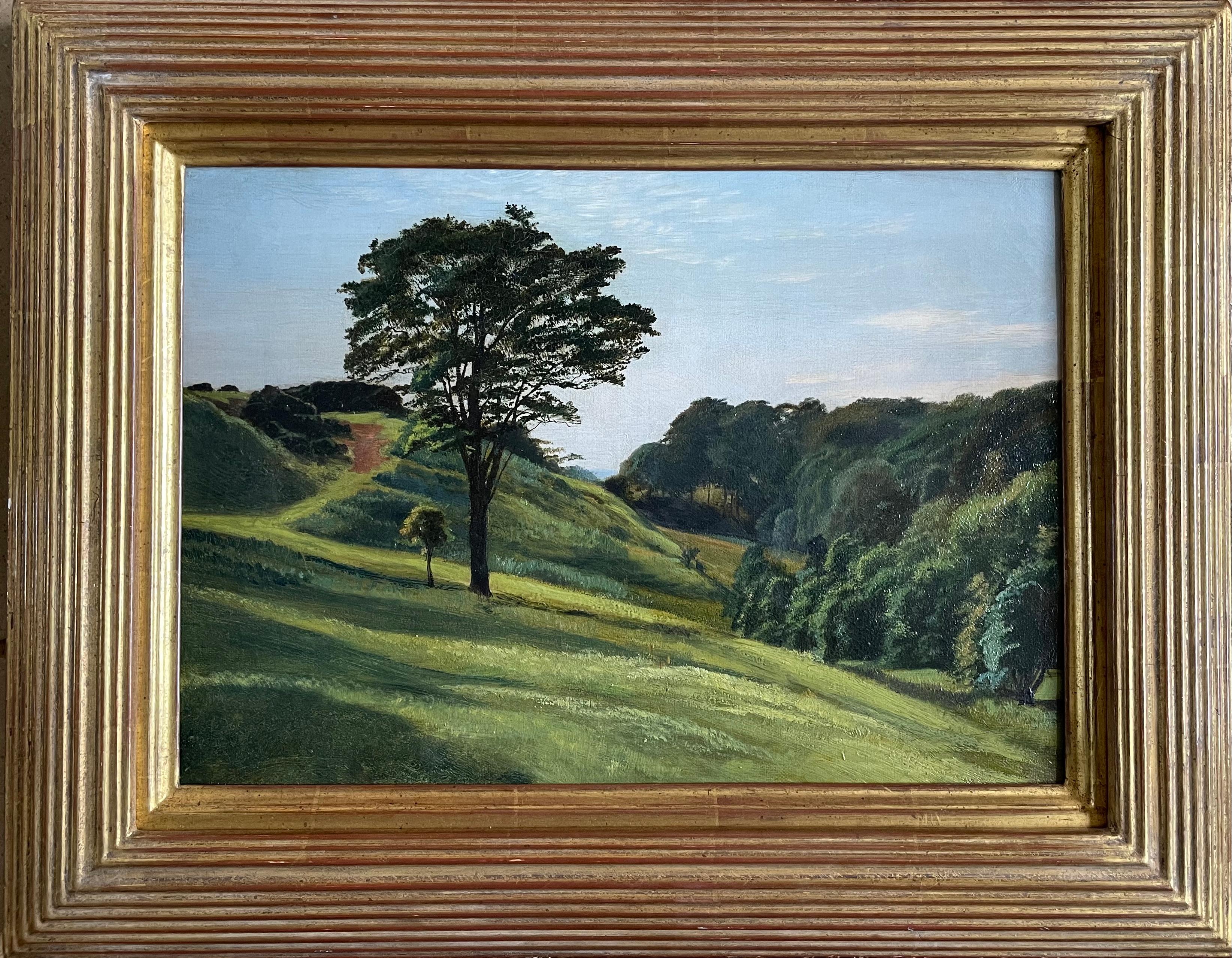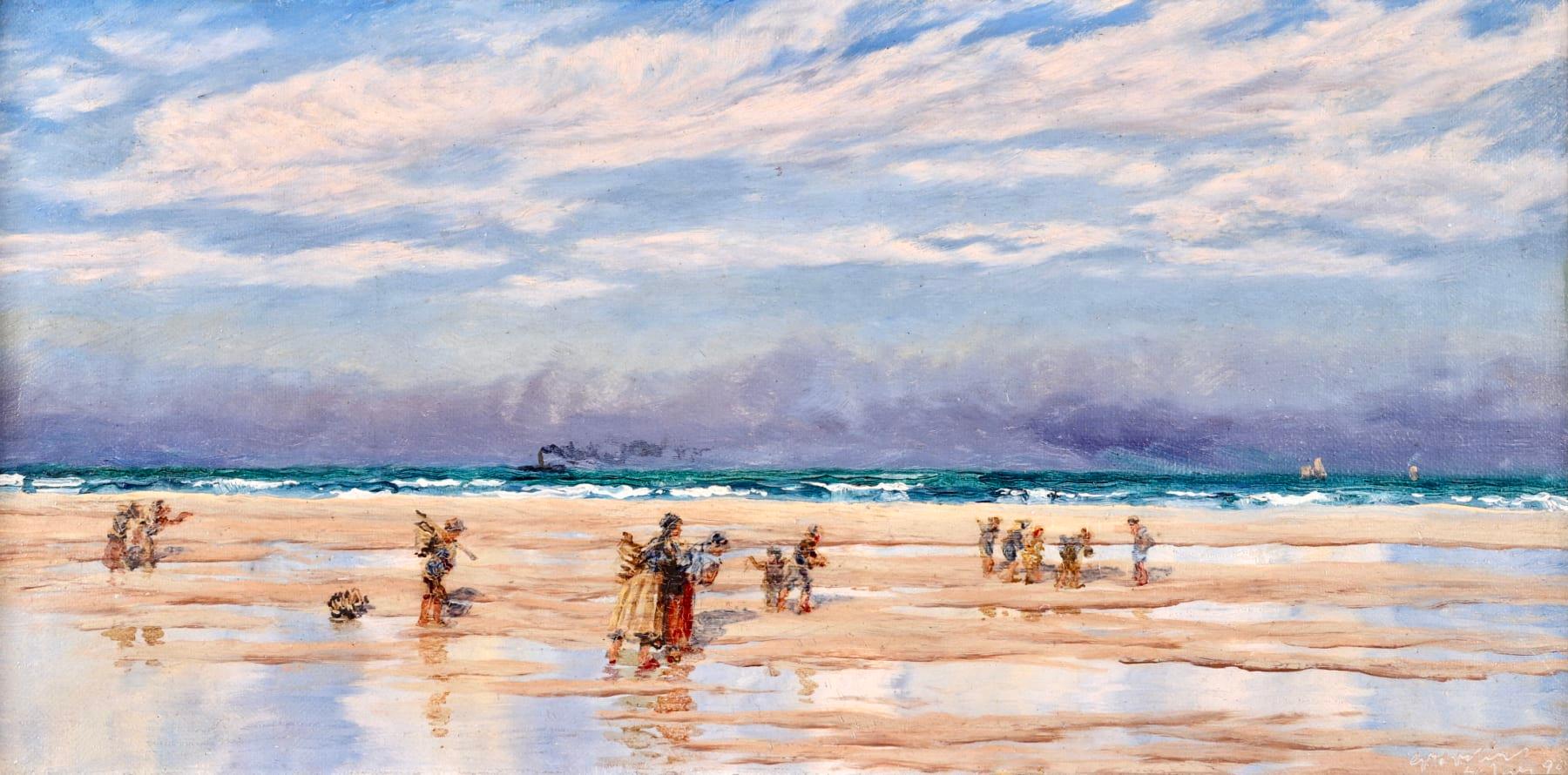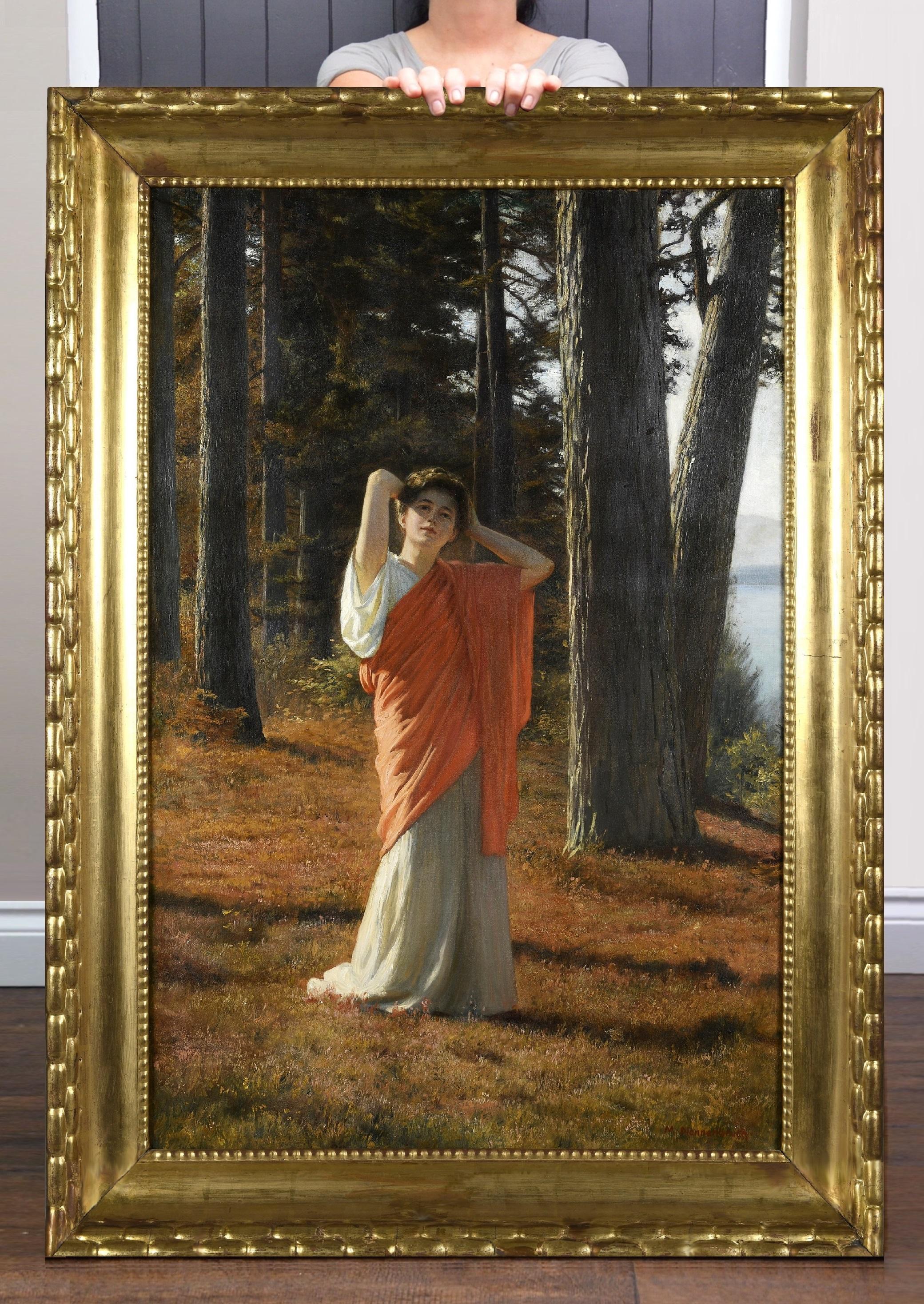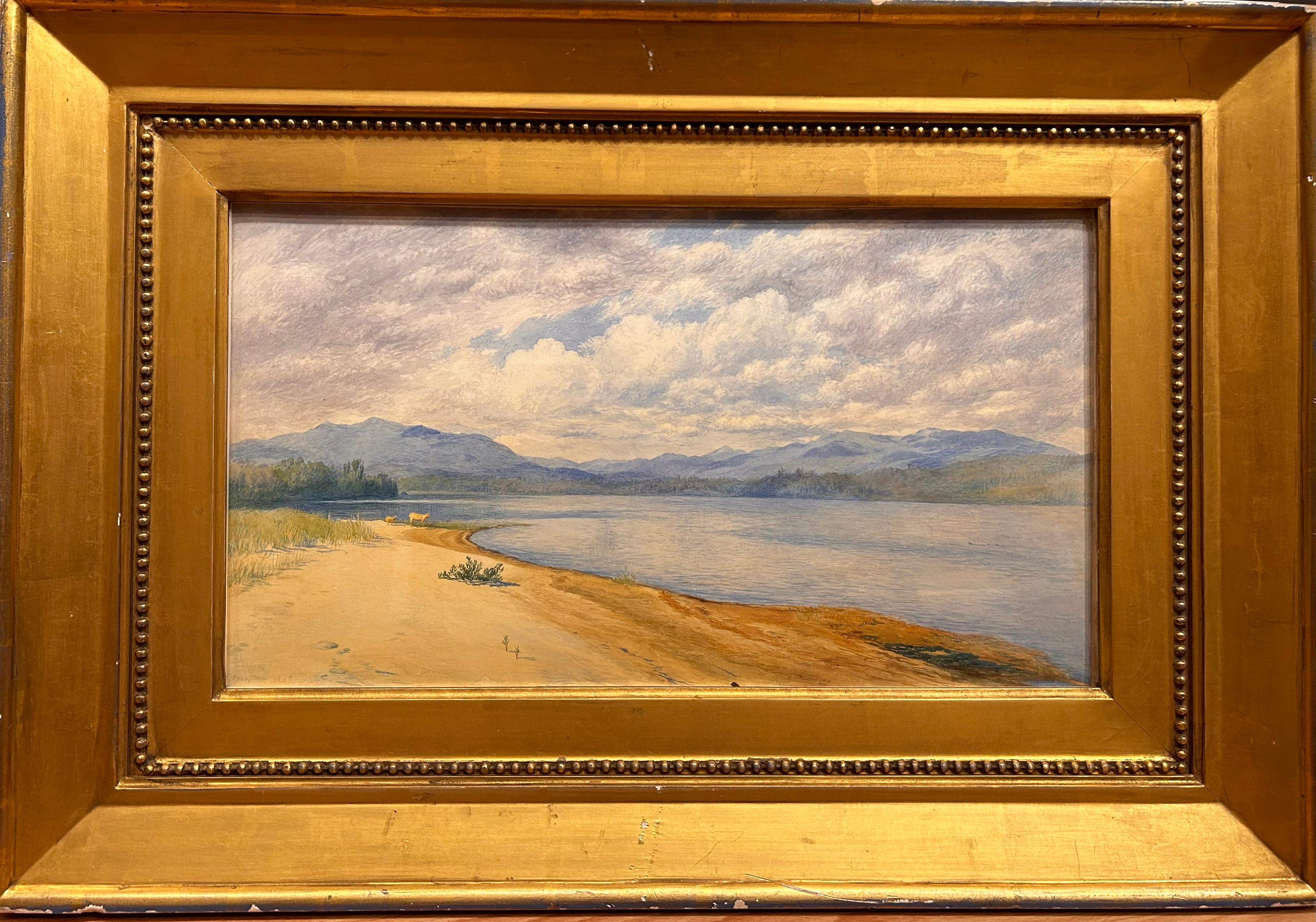Items Similar to Life Kindled of a Fiery Birth - British art 1913 landscape oil painting
Want more images or videos?
Request additional images or videos from the seller
1 of 16
Edward Steel Harper JnrLife Kindled of a Fiery Birth - British art 1913 landscape oil painting1913
1913
About the Item
This superb 1913 late Pre-Raphaelite spring landscape oil painting is by noted Birmingham artist Edward Steel Harper Junior. The title, Life Kindled from a Fiery Birth is from Swinburne's epic poem `Tristram of Lyonesse` (1882), see more details below biography. The hilly landscape is covered in vibrant yellow flowering gorse bushes that indeed appear like fire. There is also the blue of spring bluebells and trees coming into leaf in the background. Harper's landscapes in oil show his experimentation with the ‘wet white’ technique, a method used by the Pre-Raphaelite artists where white flake is spread with a palette knife onto canvas and colour then applied with sable brushes. This stunning painting is housed in a hand made brass or copper Arts and Crafts frame, which Harper would have made himself at the Birmingham School of Art. An altogether fantastic example of Harper's work.
Signed with characteristic ES [harp] ER, in part to distinguish himself from his father, who shared the same initials, and dated 1913. Signed and inscribed upon a partially fragmented label on the backboard.
Provenance. Somerset estate.
Condition. Oil on canvas, 30 inches by 24 inches and in good condition.
Frame. Housed a repousse brass or copper Arts & Crafts frame, probably designed and made at the Birmingham School of Art, 43 inches by 35 inches and in good condition. Harper studied at the Birmingham School of Art where a keen focus upon methods and materials was encouraged, especially in wood and metal. Harper was to become a proficient metalworker and an equally accomplished woodworker. Some of his more ambitious compositions have frames like this one: evidently original, carefully executed and made to complement the picture itself so that the Arts & Crafts ethos of thoughtful design and skilful manufacture in perfect harmony can be shown to good effect.
Edward Steel Harper Jnr (1878-1951) was a landscape and portrait painter from Birmingham. He was son of Edward Steel Harper Snr who was Director of the Life Academy, Municipal School of Art, Birmingham 1880-1919. He was one of three children who all became professional artists. He was Honorary Secretary and Professor of Anatomy at the Royal Birmingham Society of Artists (RBSA), Director of the Life Academy at Birmingham School of Art (1880-1919) and Art Critic for the Birmingham Post. Harper studied at the Birmingham School of Art where a keen focus upon methods and materials was encouraged, especially in wood and metal. Harper was to become a proficient metalworker and an equally accomplished woodworker. Some of his more ambitious compositions have frames like this one: evidently original, carefully executed and made to complement the picture itself so that the Arts & Crafts ethos of thoughtful design and skilful manufacture in perfect harmony can be shown to good effect. Such endeavours must have kept him busy as he is known to have painted over 2000 pictures in a exhibiting career that lasted 17 years. Elected member of the RBSA in 1915, Harper later became Art Master of Wolverhampton Grammar School until he retired in 1942. Of the 2000 pictures he painted during his lifetime, his major works include Woods by the Shore and The Breath of Spring, both of which were exhibited at the RBSA and were purchased by Birmingham Art Gallery. Harper exhibited from 1920 to 1937, at a number of leading venues, including the Royal Academy, Royal Institute of Oil Painters, Walker Art Gallery in Liverpool, as well as the RBSA. His works are in major galleries throughout the UK including Birmingham Museum & Art Gallery.
Tristram of Lyonesse is a long epic poem written by the British poet Algernon Charles Swinburne, that recounts in grand fashion the famous medieval story of the ill-fated lovers Tristan and Isolde (Tristram and Iseult in Swinburne’s version). It was first published in 1882 by Chatto and Windus, in a volume entitled Tristram of Lyonesse and Other Poems. Swinburne himself considered Tristram of Lyonesse to be the crowning achievement of his poetic career (quoted by Harrison, p. 96). The poem consists of 4488 rhyming pentameters and is divided into ten different sections: one ‘Prelude’ and nine ‘Cantos’.
- Creator:Edward Steel Harper Jnr (1878 - 1951)
- Creation Year:1913
- Dimensions:Height: 35 in (88.9 cm)Width: 43 in (109.22 cm)Depth: 2 in (5.08 cm)
- Medium:
- Movement & Style:
- Period:
- Condition:
- Gallery Location:London, GB
- Reference Number:1stDibs: LU853113194402
About the Seller
5.0
Platinum Seller
These expertly vetted sellers are 1stDibs' most experienced sellers and are rated highest by our customers.
1stDibs seller since 2018
400 sales on 1stDibs
Typical response time: <1 hour
- ShippingRetrieving quote...Ships From: London, United Kingdom
- Return PolicyA return for this item may be initiated within 14 days of delivery.
More From This SellerView All
- Manor House with Cottages - British 18thC Old Master art oil painting VG prov.By George LambertLocated in London, GBThis stunning British Old Master landscape oil painting, with excellent provenance, is by George Lambert. Lambert was a pioneer of British landscape in art for its own sake. Painted in 1744, the painting is entitled View of a Manor House and Cottages in Elizabeth Einberg's 63rd volume of the Walpole Society 2001 and is described as follows: In the foreground a road emerges from a wood to cross a ford and then leads up the hill to the right, towards a manor house seemingly built into the remains of a medieval or Tudor edifice. The main track, crowded with sheep and rustic figures, passes the massive square gateposts lower down the hill on the left. Further to the left is a thatched cottage with smoke coming out the chimney. In the distance is a wide coastal view. The main buildings, which are in the dead centre of the composition, represent almost certainly an as yet unidentified English view. The colouring and detail in the trees and foliage are superb. This is an excellent Old Master oil painting by one of the all time great British landscape artists with extensive provenance. Signed and dated 1744 lower left on rock in black. Provenance. Elizabeth Einberg, “Catalogue Raisonnè of the works of George Lambert” The Annual Volume of the Walpole Society, 2001 Vol. 63, page 149 no P1744, fig.71. Antonacci Efrati Antichità Rome Gallery. Burden sale, Parke Bernet, New York, 20-21, April 1938 (376 repr.) Robert E. Peters, Sotheby Parke Bernet, New York, March 1975 (41 repr.) Lit. Schnackenburg 1995, pp 83-84, cat. no.14 fig 13. Condition. Oil on canvas, 54 inches by 52 inches and in good condition. Frame. Housed in an ornate gilt frame, 64 inches by 62 inches and in good condition. George Lambert (1700-1765) was an English landscape artist and theatre scene painter. With Richard Wilson he is recognised as a pioneer of British landscape in art, for its own sake. Lambert was born in Kent and studied art under Warner Hassells and John Wootton, soon attracting attention by the quality of his landscape painting. He painted many large and fine landscapes in the style of Gaspar Poussin and Salvator Rosa. Many of his landscapes were finely engraved by François Vivares, James Mason (1710–1785), and others, including a set of views of Plymouth and Mount Edgcumbe (painted conjointly with Samuel Scott), a view of Saltwood Castle in Kent, another of Dover, and a landscape presented to the Foundling Hospital in London. Lambert also obtained a great reputation as a scene-painter, working at first for the Lincoln's Inn Fields Theatre, in London, under John Rich. When Rich moved to Covent Garden Theatre, Lambert secured the assistance of Amigoni, and together they produced scenery of far higher quality than any previously executed. Lambert was a man of jovial temperament and shrewd wit, and frequently spent his evenings at work in his painting-loft at Covent Garden Theatre, to which men of note in the fashionable or theatrical world resorted to share his supper of a beef-steak, freshly cooked on the spot. Out of these meetings arose the well-known "Beefsteak Club" which long maintained a high social reputation. Most of Lambert's scene-paintings unfortunately perished when Covent Garden Theatre was destroyed by fire in 1808. Lambert was a friend of William Hogarth and a member of the jovial society that met at 'Old Slaughter's' Tavern in St Martin's Lane. In 1755 he was one of the committee of artists who proposed a royal academy of arts in London. He was a member of the Society of Artists of Great Britain, exhibited with them in 1761 and the three following years, and during the same period contributed to the Academy exhibitions. In 1765 he and other members seceded and formed the Incorporated Society of Artists of Great Britain, of which he was elected the first president. In conjunction with Samuel Scott, Lambert painted a series of Indian views for the old East India House in Leadenhall Street. He also etched two prints after Salvator Rosa. Lambert was associated in 1735 with George Vertue, Hogarth, and John Pine (engraver, 1660–1756) in obtaining a bill from parliament securing artists a copyright on their works. Lambert's portraits were painted by Thomas Hudson, John Vanderbank (engraved in mezzotint by John Faber the younger in 1727, and in line by H. Robinson and others), and Hogarth. Lambert's most famous painting is "A view of Box Hill, Surrey" (1733) which depicts a well-known beauty spot south of London. Hogarth considered Lambert a rival to the famous French landscape painter Claude Lorrain (1600–1682) with respect to his use of soft light to unify the scene in this painting. Though he never visited Italy he was inspired by the classical tradition of landscape painting. Lambert died on 30 November 1765 at his home on the Piazza in Covent Garden. His pupils included John Inigo Richards...Category
Mid-18th Century Old Masters Landscape Paintings
MaterialsOil
- Dedham Watermill - British 19thC art landscape oil painting Constable countryBy Frederick Waters WattsLocated in London, GBThis lovely oil painting, circa 1850, is by Frederick Waters Watts (1800-1862), a highly desired landscape painter from the 19th century. The painting titled "Dedham Watermill" is in...Category
19th Century Impressionist Landscape Paintings
MaterialsOil
- Lock on the Stour - British 19th century art river landscape oil paintingBy Frederick Waters WattsLocated in London, GBThis lovely landscape oil painting is by 19th century British artist Frederick Waters Watts. The painting dating to 1850 depicts lock gates on the Stour opening above for the waiting...Category
19th Century Realist Landscape Paintings
MaterialsOil
- Autumn Forms - Scottish Abstract art 20th century oil painting red white blueBy Iain RobertsonLocated in London, GBThis striking Abstract oil painting is by Scottish artist Iain Robertson. It was painted in 1997 just before he moved to Cornwall. The painting is a riot of red, white and blue with heavy impasto which works beautifully. Signed and inscribed with title and dated 1997 verso. Provenance. Scottish estate. Condition. Oil on canvas, image size 24 inches by 18 inches and in good condition. Housed in a white surround frame, 26 inches by 20 inches framed and in good condition. Iain Robertson (b. 1955) was born in Cyprus but grew up in Edinburgh before studying art, 1978-1982. In 1993 he worked as Artist In Residence at Grizedale Sculpture Park before relocating to Cornwall where he now lives and works. He has retained studio 7 at Porthmeor Studios in St Ives, since 2007. Previously Robertson worked in Montgomery Street Studio, Edinburgh, 1991-1999. He has exhibited widely with numerous solo shows in the UK and Europe. His work is held in public and private collections in Germany, Denmark, Norway, Scotland, England, USA and Hong Kong. His work was included in the ‘Art Now Cornwall’ exhibition at TATE St Ives Spring 2007 and at the City Art Centre, Edinburgh, 2007. The recipient of a number of awards including Scottish Arts Council, British Council and Arts Council, Robertson was the first Scottish recipient of the Pollock Krasner Foundation, New York, in 1988. Notable exhibitions include, Contemporary Abstract Printmaking, Artists- Rachel Clark, Ian Davenport, Christopher Le Brun, John McLean, Mali Morris...Category
20th Century Abstract Abstract Paintings
MaterialsOil
- Landscape with Sheep - Scottish 19th century Kirkcudbright art oil paintingLocated in London, GBThis lovely Scottish Victorian Impressionist oil painting is by noted Kirkcudbright artist William Mouncey. Painted circa 1890 it is a landscape of a shepherd and his flock under tre...Category
1890s Impressionist Landscape Paintings
MaterialsOil
- Glasgow West End River Kelvin Townscape - Scottish 1950's landscape oil paintingLocated in London, GBThis superb Scottish Impressionist townscape oil painting is by noted Slade School trained artist Sir Harry Jefferson Barnes. Originally from Sheffield Barnes was very involved with ...Category
1950s Realist Landscape Paintings
MaterialsOil
You May Also Like
- George Howard, Earl of Carlisle - BritishPre-Raphaelite Landscape OilLocated in London, GBGEORGE HOWARD, 9th EARL OF CARLISLE (1843-1911) Lanercost, Cumbria Oil on canvas Framed 25 by 35.5 cm., 10 by 14 in. (frame size 37 by 47 cm., 14 ½ by 18 ½ in.) Provenance: Lady Cecilia Howard, daughter of George Howard, 9th Duke of Carlisle, and thence my descent George James Howard, 9th Earl of Carlisle was an aristocrat, Liberal politician, artist. He was a friend and important patron to a number of artists in the Pre-Raphaelite circle, being particularly close to Burne-Jones. As well as Naworth Castle near Carlisle and Castle Howard...Category
Late 19th Century Pre-Raphaelite Landscape Paintings
MaterialsOil
- Oil Painting of Trees by Pre-Raphaelite George Howard, 9th Earl of CarlisleLocated in London, GBGEORGE HOWARD, 9th EARL OF CARLISLE (1843-1911) A Line of Trees Oil on panel Framed 26.5 by 36.5 cm., 10 ½ by 14 ½ in. (frame size 37 by 47.5 cm., 14 ½ by 18 ¾ i.) Provenance: La...Category
Late 19th Century Pre-Raphaelite Landscape Paintings
MaterialsOil
- Gathering Cockles - Pre-Raphaelite Figures in Landscape Oil by John Edward BrettBy John Edward Brett ARALocated in Marlow, BuckinghamshireSigned and dated figurative oil on canvas by English Pre-Raphaelite painter John Edward Brett. In 1896 John Brett and his wife Mary went to Paris, the first time the artist had been ...Category
1890s Pre-Raphaelite Figurative Paintings
MaterialsCanvas, Oil
- Diana Nemorensis - 19th Century NeoClassical Oil Painting of Roman GoddessBy Max NonnenbruchLocated in Gerrards Cross, GB‘Diana Nemorensis’ by Max Nonnenbruch (1857-1922). The painting – which depicts the Goddess Diana of the Woods beside Lake Nemi – is signed by the artist and presented in a fine gol...Category
Late 19th Century Pre-Raphaelite Figurative Paintings
MaterialsOil
- Diana Nemorensis - 19th Century NeoClassical Oil Painting of Roman GoddessBy Max NonnenbruchLocated in Gerrards Cross, GB‘Diana Nemorensis’ by Max Nonnenbruch (1857-1922). The painting – which depicts the Goddess Diana of the Woods beside Lake Nemi – is signed by the artist and presented in a fine gol...Category
Late 19th Century Pre-Raphaelite Figurative Paintings
MaterialsOil
- Landscape of Summer At Lake George, NYBy John Henry HillLocated in Fredericksburg, VAJohn Henry Hill was a distinguished landscape painter and engraver of the American Pre-Raphaelite tradition. A lifelong resident of West Nyack, New York, John Henry Hill was influenc...Category
Mid-19th Century Pre-Raphaelite Landscape Paintings
MaterialsWatercolor, Paper





